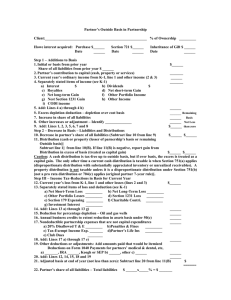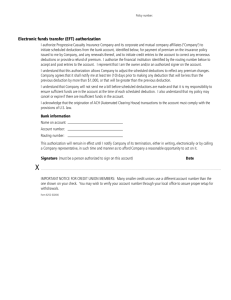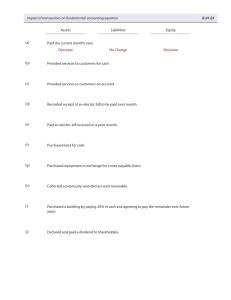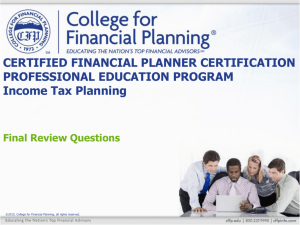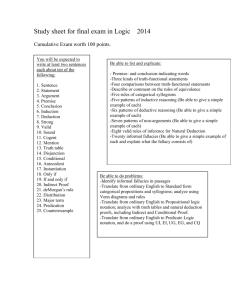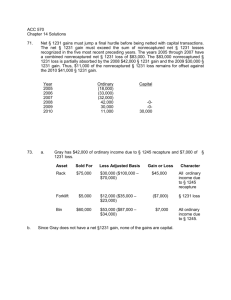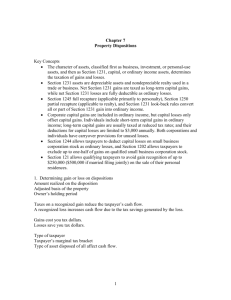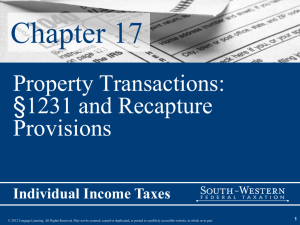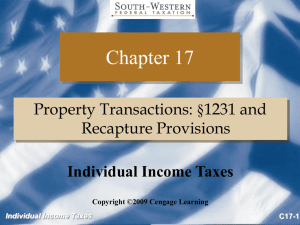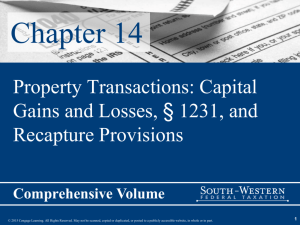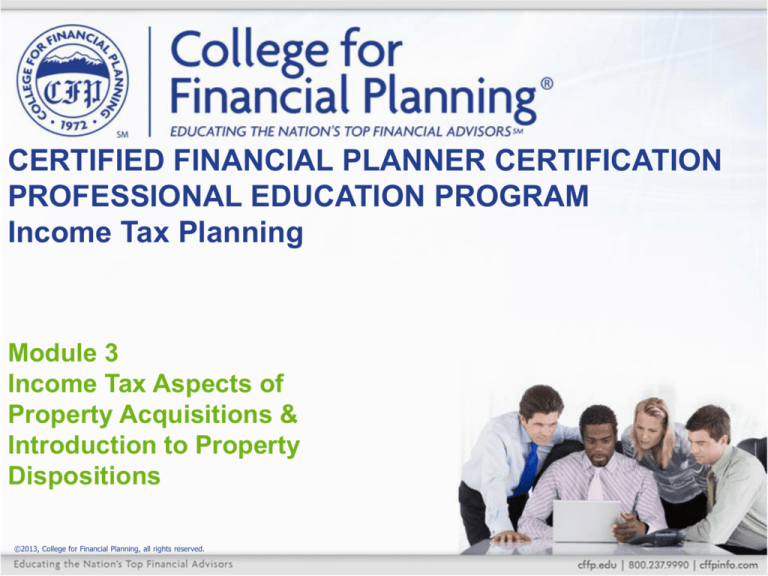
CERTIFIED FINANCIAL PLANNER CERTIFICATION
PROFESSIONAL EDUCATION PROGRAM
Income Tax Planning
Module 3
Income Tax Aspects of
Property Acquisitions &
Introduction to Property
Dispositions
©2013, College for Financial Planning, all rights reserved.
Learning Objectives
3–1: Identify the type of property in a situation.
3–2: Analyze a situation to determine the correct
treatment for property-related expenditures.
3–3: Analyze a situation to calculate the adjusted basis of
property.
3–4: Analyze a situation to calculate the cost recovery
deductions over the recovery period.
3–5: Analyze a situation to calculate the election or
deduction amount under Section 179.
3–6: Analyze a situation to calculate the amount of cost
recovery recapture, or unrecaptured Section 1250
income.
3–7: Analyze a situation to determine the tax treatment of
Section 1231 property transactions.
3-2
Questions to Get Us Warmed Up
3-3
Learning Objectives
3–1: Identify the type of property in a situation.
3–2: Analyze a situation to determine the correct
treatment for property-related expenditures.
3–3: Analyze a situation to calculate the adjusted basis of
property.
3–4: Analyze a situation to calculate the cost recovery
deductions over the recovery period.
3–5: Analyze a situation to calculate the election or
deduction amount under Section 179.
3–6: Analyze a situation to calculate the amount of cost
recovery recapture, or unrecaptured Section 1250
income.
3–7: Analyze a situation to determine the tax treatment of
Section 1231 property transactions.
3-4
Types of Property
Realty
• Land, anything permanently affixed or
attached to the land, and certain items that
cannot easily be removed
Personalty
(sometimes known as “personal property”)
• Any type of property that is not realty,
including such items as automobiles, jewelry,
clothing, equipment, and furniture
3-5
Types of Property
Tangible Property
• Property that has physical existence and can be
touched and felt
Intangible Property
• Property, such as a leasehold interest in real estate
or a stock certificate, that has no physical
existence of its own, but represents the evidence
of ownership or value
3-6
Types of Property
Trade or Business
• Property used on a regular and continuous basis in
the taxpayer’s trade, business, or occupation to
produce income
Production of Income
• Property that does not require a significant amount
of the taxpayer’s time or attention
3-7
Types of Property
Inventory
• Property held for resale in the normal course of a
trade or business
Personal Use
(NOT the same as personal property)
• Property held for the taxpayer’s personal pleasure
or enjoyment
3-8
Property-Related Expenditures
Not Currently
Deductible
• Those incurred
purely for
personal
reasons by the
taxpayer
(generally)
• Exception:
Itemized
deductions
Currently
Deductible
• Ordinary and
necessary
expenses
incurred to carry
on a trade or
business—§162
expenses
Capitalized and
Amortized
or Depreciated
• The purchase of
property or
improvements
to property that
extend beyond
the taxable year
or that provide
a benefit for
more than one
tax year
3-9
Tax Basis
Purchased Property
Original costs plus acquisition costs and
cost of subsequent capital improvements,
less amount of cost recovery deduction
claimed
Inherited Property
Generally, equal to fair market value (FMV)
on decedent’s death, or
FMV on alternate valuation date (exactly six
months after decedent’s death) if so
elected
3-10
Tax Basis
Property Acquired by
Gift
Donor’s basis, unless fair market value
(FMV) of property on date gifted is lower
than donor’s basis:
- If eventually sold for less than FMV on
date received, basis becomes value on
date received
- If eventually sold for more than donor’s
basis, basis becomes donor’s cost
- If eventually sold for value between FMV
on date received and donor’s basis,
taxpayer reports neither gain nor loss
-Tacking of holding period if donor’s basis
used
3-11
Learning Objectives
3–1: Identify the type of property in a situation.
3–2: Analyze a situation to determine the correct
treatment for property-related expenditures.
3–3: Analyze a situation to calculate the adjusted basis of
property.
3–4: Analyze a situation to calculate the cost recovery
deductions over the recovery period.
3–5: Analyze a situation to calculate the election or
deduction amount under Section 179.
3–6: Analyze a situation to calculate the amount of cost
recovery recapture, or unrecaptured Section 1250
income.
3–7: Analyze a situation to determine the tax treatment of
Section 1231 property transactions.
3-12
Cost Recovery: MACRS
Defined
Recover cost of wasting asset over time period
approximating asset’s useful life
Personalty
• MACRS table (200% DB w/ ½ year convention)
• Straight-line option for personalty
• Section 179 expense election
• 50% bonus depreciation
o May elect out for entire class of property
Realty
• Straight-line mandatory for real estate
3-13
Section 179 Expense Election
• Election to immediately expense
• Up to $500,000 (for 2013) of qualifying property
Qualifying property
• Tangible
• Personalty
• For use in active conduct of a trade or business
Limitations
• Phaseout for property placed in service over
$2 million
• Taxable income limitation
3-14
Learning Objectives
3–1: Identify the type of property in a situation.
3–2: Analyze a situation to determine the correct
treatment for property-related expenditures.
3–3: Analyze a situation to calculate the adjusted basis of
property.
3–4: Analyze a situation to calculate the cost recovery
deductions over the recovery period.
3–5: Analyze a situation to calculate the election or
deduction amount under Section 179.
3–6: Analyze a situation to calculate the amount of cost
recovery recapture, or unrecaptured Section 1250
income.
3–7: Analyze a situation to determine the tax treatment of
Section 1231 property transactions.
3-15
Cost Recovery Recapture
Calculating Cost Recovery Recapture on
Section 1245 Property*
Calculate gain
realized and
recognized.
Calculate Section
1245 gain
Calculate Section
1231 gain
Lesser of: cost
recovery
deductions taken
or gain realized.
Gain recognized
less Section
1245 gain.
*Assumes no basis adjustments other than cost recovery deductions.
3-16
Section 1245 Recapture
Sale Price
$15
Cost Basis
$10
Depreciation
Adjusted Basis
Sale Price
$(7)
§1231
Potential LTCG
§1245 Income
Cost Recovery
Recapture
Ordinary Income
$3
$1
§1231
Ordinary Loss
3-17
Unrecaptured Section 1250 Income
Sale Price
$15
Cost Basis
$10
S/L Depreciation
Adjusted Basis
Sale Price
$(7)
§1231
LTCG
Unrecaptured §1250
Income
(Type of §1231 gain)
25% LTCG
$3
$1
§1231
Ordinary Loss
3-18
Section 1231 Lookback
• Lookback period—5 years
• If unrecaptured §1231 losses during lookback
•
period
Current year net §1231 gains
treated as ordinary income
3-19
Review Question 1
A leasehold interest in an apartment building is
considered
a. tangible realty.
b. tangible personalty.
c. intangible realty.
d. intangible personalty.
3-20
Review Question 2
A taxpayer purchases a new computer for use in his
consulting business. He incurs sales taxes and shipping
charges in connection with the purchase.
Which one of the following correctly describes
treatment of the sales taxes and shipping charges?
a. Both are currently deductible.
b. Both are capitalized.
c. The sales taxes are capitalized, and the shipping
charges are currently deductible.
d. The sales taxes are currently deductible, and the
shipping charges are capitalized.
3-21
Review Question 3
Don Reeves purchased a small duplex for use as a
rental property. After the property was placed in
service, he made some improvements; and later in the
year, he made some repairs to the property.
Which one of the following statements is correct
regarding treatment of the expenditures?
a. The improvements and repairs must be capitalized.
b. The improvements must be capitalized; the repairs
are currently deductible.
c. The improvements are currently deductible; the
repairs must be capitalized.
d. The improvements and repairs are currently
deductible.
3-22
Review Question 4
The basis of an asset acquired by inheritance
generally is
a. the greater of the decedent’s adjusted basis
or the fair market value on the date of
death.
b. the lesser of the decedent’s adjusted basis
or the fair market value on the date of
death.
c. the decedent’s adjusted basis.
d. the fair market value on the date of death.
3-23
Review Question 5
This year, Jeff Walker purchased a parcel of raw
land on which he could construct a new building
for his hardware business. He paid $50,000 for
the land and incurred $500 in legal fees
associated with the title search. Property taxes
on the land have totaled $1,200 annually.
What is Jeff’s adjusted basis in the land?
a. $50,500
b. $51,200
c. $51,700
3-24
Review Question 6
Two years ago, Jeff Walker purchased new office
equipment for use in his hardware business. The
cost of the equipment was $15,000, and freight
and installation costs totaled $500. He received a
first-year cost recovery deduction of $2,215 and a
second-year cost recovery deduction of $3,796.
What is Jeff’s adjusted basis in the equipment?
a. $8,989
b. $9,489
c. $15,000
d. $15,500
3-25
Review Question 7
Two years ago, Sam Jones received a gift of
100 shares of common stock from his parents.
The fair market value of the stock on the date
of the gift was $10 per share. His parents had
purchased the stock four years earlier at $3 per
share. Sam sold this stock for $12 per share last
week.
What was Sam’s per share basis in the stock
when it was sold?
a. $3
b. $10
c. $12
3-26
Review Question 8
Jerry’s uncle gave him 100 shares of ABC, Inc.,
common stock. The fair market value of the
stock on the date of the gift was $20 per share.
Jerry’s uncle had purchased the stock 22
months earlier at $30 per share. Jerry sold his
holdings of the stock for $24 per share three
weeks ago.
What was Jerry’s gain or loss on the sale of the
stock?
a. ($600)
b. $0
c. $400
3-27
Review Question 9
Mary purchased a used pickup truck at a cost of
$4,200 with sales taxes of $300, to use in her
delivery business. She purchased the pickup
(5-year property) and placed it in service on
January 1 of the current year.
Using MACRS, what is the first-year cost
recovery deduction that Mary can claim?
a. $450
b. $900
c. $1,800
3-28
Review Question 10
Bill purchased an automobile at a cost of $7,500 to
use in his pizza delivery business. He also paid
$500 in sales taxes on the vehicle. He purchased
the automobile (5-year property) and placed it in
service on March 1 of the current tax year.
Using the straight-line method available as an
option under MACRS, what is the first-year cost
recovery deduction that Bill can claim?
a. $750
b. $800
c. $1,500
d. $1,600
3-29
Review Question 11
Frank Jones owns and operates a small
business as a sole proprietor. On August 7,
2013, he purchased equipment (7-year
property) at a cost of $625,000 to use in his
business. He qualifies for and elects the
maximum Section 179 expense deduction.
What is the total amount of deductions that
Frank can claim in 2013? Use the MACRS table.
a. $375,000
b. $500,000
c. $517,863
d. $625,000
3-30
Review Question 12
Mary Grey purchased office furniture several
years ago at a cost of $4,500 to use in her
business. She claimed $3,295 of cost recovery
deductions. She sold the furniture for $3,000.
What is the amount and character of the gain
or loss resulting from this disposition?
a. $1,500 ordinary loss
b. $1,500 capital loss
c. $1,795 of ordinary income, $0 long-term
capital gain
d. $1,795 long-term capital gain, $0 of ordinary
income
3-31
Review Question 13
Julio Gallardo owns and operates a manufacturing plant
as a sole proprietor. He purchased a machine used in
the manufacturing process at a cost of $12,000 several
years ago. Julio sold the machine for $16,000 after
claiming $3,184 of cost recovery deductions.
Calculate the amount and nature (character) of the gain
or loss resulting from this disposition.
a. $3,184 of ordinary income, $4,000 long-term capital
gain
b. $4,000 of ordinary income, $3,184 long-term capital
gain
c. $7,184 of ordinary income
d. $7,184 long-term capital gain
3-32
Review Question 14
Which one of the following statements is correct
regarding the tax treatment of Section 1231
and 1245?
a. Net Section 1231 gains are treated as
ordinary income.
b. Net Section 1231 gains are treated as longterm capital gains.
c. Section 1245 income is treated as capital
gain income.
d. Section 1245 losses are treated as ordinary
losses.
3-33
Review Question 15
During the current year, Peter Langley has Section 1231
gains totaling $8,000. He also has $1,000 of Section
1231 losses. Four years ago, Peter reported a net
Section 1231 loss of $2,000. These are the only two
years in which Peter has had Section 1231 gains or
losses.
What is the amount and character of the current year’s
Section 1231 gains and losses?
a. $2,000 of ordinary income, $5,000 long-term capital
gain
b. $5,000 of ordinary income, $2,000 long-term capital
gain
c. $7,000 of ordinary income
d. $7,000 long-term capital gain
3-34
Review Question 16
In 2013, Kevin Allen purchased various items of
depreciable tangible personal property with a total cost
of $528,000 for use in his business. Kevin has taxable
income (without regard to the Section 179 deduction)
of $116,000 from his business. He also has wages from
a part-time job of $14,000.
What is the maximum Section 179 expense deduction
that Kevin may claim in 2013?
a. $116,000
b. $130,000
c. $500,000
d. $528,000
3-35
CERTIFIED FINANCIAL PLANNER CERTIFICATION
PROFESSIONAL EDUCATION PROGRAM
Income Tax Planning
Module 3
End of Slides
©2013, College for Financial Planning, all rights reserved.

